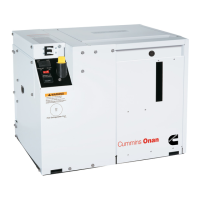11-4
TABLE 11-1. TROUBLESHOOTING GENSET FAULTS (CONT.)
@@@@ Some genset service procedures present hazards that can result in severe personal
injury or death. Only trained and experienced service personnel with knowledge of fuels, electricity,
and machinery hazards should perform genset service. See Safety Precautions.
Accidental or remote starting can cause severe personal injury or death. Before removing a panel or
access door, disconnect the negative (–) cable from the battery to prevent the engine from starting.
WARNING
HIGH ENGINE TEMPERATURE—CODE NO. 1
Control Logic: Engine coolant temperature exceed design limit
Corrective Action: Refer to Pages A-1 through A-3 as appropriate.
1. Open the sea valve.
2. Check for and clean a blocked sea water strainer. If above the water line, fill the strainer with water to
assist priming.
3. Check engine coolant level, add coolant as necessary and check for and repair leaks (p. 4-6).
4. Check for and reconnect or replace any disconnected, kinked or leaking raw water hoses.
5. Check for and readjust a loose pump belt (p. 4-9).
6. Check for a worn raw water impeller and replace as necessary (p. 4-10).
7. Clean the heat exchanger (p. 4-12).
8. Check the bottom of the hull for any blockage at the through-hull fitting.
9. Drain and clean the cooling system to remove fouling (p. 4-6).
10. Replace the coolant thermostat, which might not be opening fully (p. 4-8).
11. If loose, tighten the ring terminal on coolant sender E2 (p. 9-6).
12. Test coolant sender E2 and replace if necessary (p. 9-6).
13. Disconnect connector P1 (black) from the genset controller (p. 9-1) and check for electrical continuity
between Pin 9 and the ring terminal on sender E2. If it is an isolated-ground sender, also check for elec-
trical continuity between E2-2 and B– (ground). Repair wiring and connectors as necessary.
LOW OIL PRESSURE—CODE NO. 2
Control Logic: Low oil pressure
Corrective Action: Refer to Pages A-1 through A-3 as appropriate.
1. Check the engine oil level and add or drain oil as necessary (p. 4-3). Repair any oil leaks.
2. If loose, tighten the ring terminal on oil pressure sender E1 (p. 9-6).
3. Check electrical resistance through sender E1 (p. 9-6) and replace if necessary.
4. Disconnect connector P1 (black) from the genset controller (p. 9-1) and check for electrical continuity
between Pin 10 and the ring terminal on sender E1. If it is an isolated-ground sender, also check for
electrical continuity between E1-2 and B– (ground). Repair wiring and connectors as necessary.
5. Replace the sender with a gauge, ground the sender wire (to keep the engine running) and start the
engine. Shut down the engine immediately if there is no oil pressure. Service the engine lubrication
system in accordance with the engine Workshop Manual (p. 6-1) if oil pressure is less than 14 psi
(98 kPa).
Redistribution or publication of this document,
by any means, is strictly prohibited.

